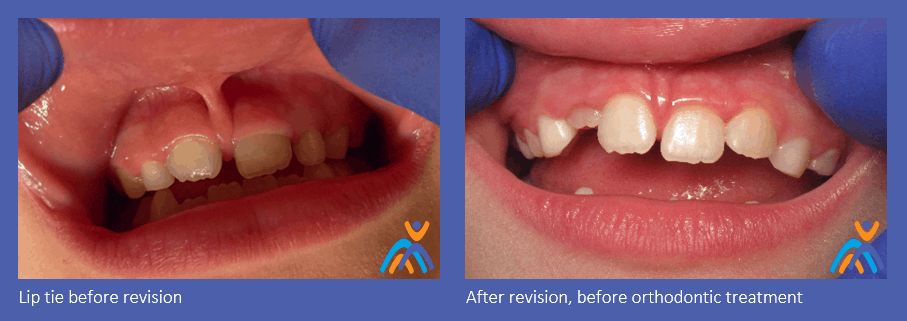We have talked a lot about how tongue and lip ties can affect the breastfeeding relationship for moms and babies, but it’s important to acknowledge how ties can affect older children and adults as well.
When we see infants for lip and tongue ties, Dr. Kogut and Dr. Alex diagnose and treat based upon function rather than appearance. At times, an infant may have a frenum that appears thick and restrictive, but does not have any difficulty breastfeeding, bottle feeding, or keeping erupting teeth clean. As the mouth grows and develops, lip and tongue ties may begin to present symptoms if left uncorrected. Frenectomies can be performed at any age, and can be life-changing to a person’s oral function, confidence, and overall health.
We frequently treat older patients who are experiencing orthodontic issues related to their ties. If the frenum attached to the lip wraps around the gums between the teeth, it can cause a noticeably large gap between the front teeth. Not every gap is the result of a lip tie, however closing a gap where a lip tie is present can be difficult to accomplish with orthodontic treatment alone. Braces can close the gap temporarily, by bunching the frenum between teeth, but when treatment is complete the frenum usually pushes the front teeth to their original places. A frenectomy removes this tissue and allows the teeth to successfully stay together.
Another indicator of undiagnosed lip ties is decay along the gumline of the front teeth. If the lip is tightly tethered to the gums, milk, food, and juice become trapped at the gumline and will eat away at the teeth. Brushing is also a challenge in this area, as it can be difficult and painful to lift the lip enough to clear food from the gumline. When this occurs in children, treating a lip tie before permanent teeth erupt will help prevent the decay of the new teeth.
Untreated tongue ties carry their own set of complications for older children and adults, the most common being issues with speech development. When speaking, the tongue has to be in a specific place in the mouth to correctly produce each unique sound. If the tongue is unable to move and lift to reach the palate, many of these sounds (such as ‘th,’ ‘ch,’ and ‘s’) can be difficult or impossible to achieve. A frenectomy can reduce this restriction and allow the tongue more mobility and control. Working with a speech-language pathologist (SLP) or speech-language therapist (SLT) before AND after a frenectomy will help improve the strength and range of motion of the tongue, and provide the best opportunity for correct speech.

The Importance of Treatment
Similarly, the tongue plays a large role in how we eat. One of the most important jobs of the tongue is to assist in safely swallowing while we eat or drink. Often seen in children transitioning to solid foods, a tongue tie can make it very difficult to successfully transfer food. These children might frequently choke or gag while eating, chew food and spit it out, or pocket the food in their cheeks or behind their lips to avoid swallowing it. Sometimes mistaken for pickiness, a tongue tie may cause these children to avoid certain food groups or textures altogether. In conjunction with a frenectomy, a licensed feeding therapist can help these children overcome aversions to different foods or textures and retrain the tongue’s movement and placement while eating.


Learn More About Lip & Tongue Ties
Many lip and tongue ties in older children and adults go unrecognized and untreated for years. The symptoms are often misdiagnosed or attributed to other conditions. If you or your child are experiencing any of the above symptoms and you suspect a lip and/or tongue tie, we would love to assist you and answer any questions you have.
Want to learn more about lip and tongue ties? Get more info here, or check out the blog post we wrote for our friends at Dallas Mom’s Blog! Learn more about frenectomy recovery and aftercare tips.

















